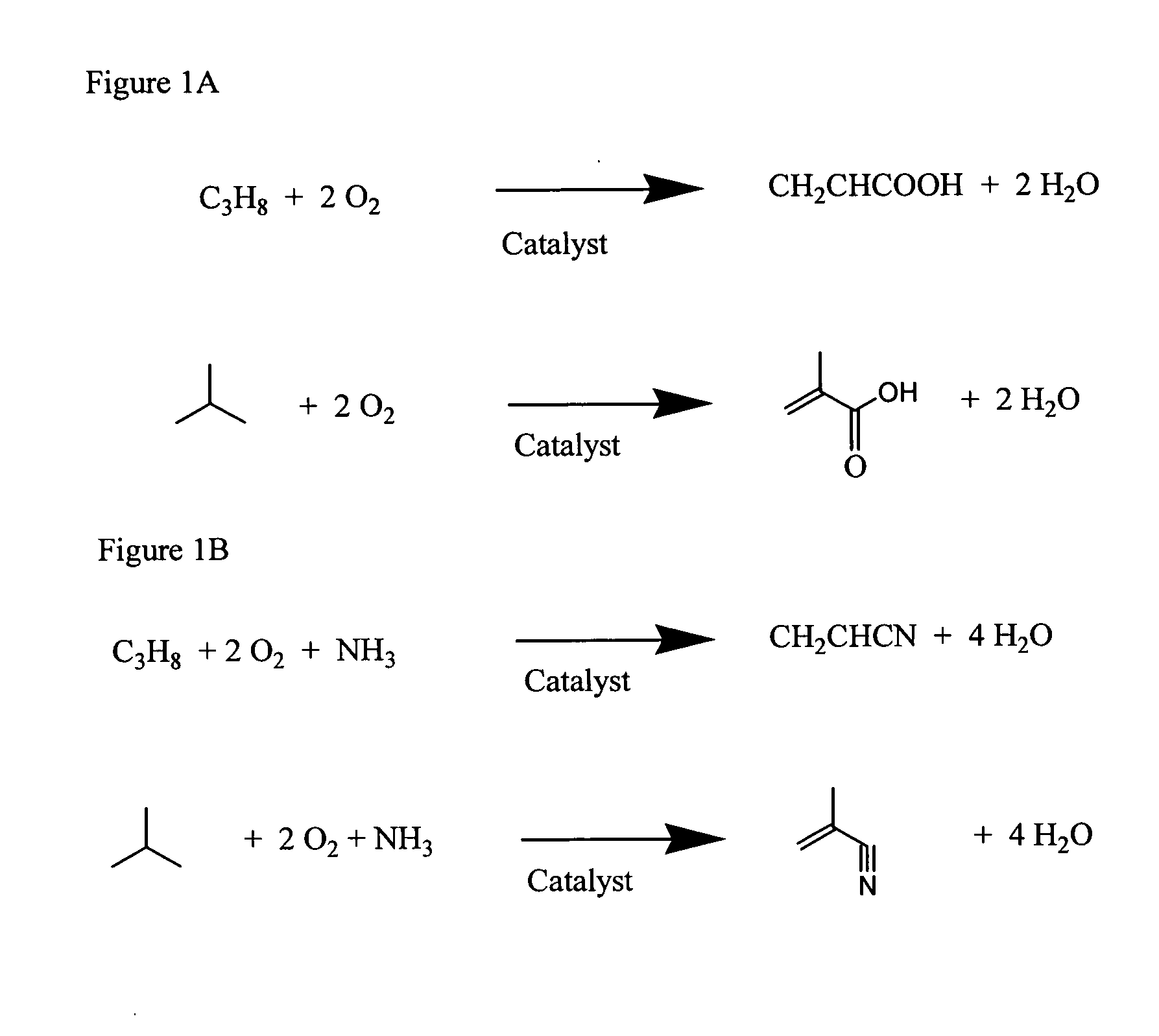Mixed metal oxide catalysts for propane and isobutane oxidation and ammoxidation, and methods of preparing same
a metal oxide catalyst and propane technology, applied in the field of catalyst compositions, can solve the problems of difficult reproduction of synthesis protocols known in the art for such catalyst systems, low yield of desired product of art-known catalytic systems, etc., and achieve the effect of improving yield
- Summary
- Abstract
- Description
- Claims
- Application Information
AI Technical Summary
Benefits of technology
Problems solved by technology
Method used
Image
Examples
example 1
A catalyst was prepared where the atomic ratio of Mo / V / Sb / Nb was 1 / 0.37 / 0.13 / 0.1 in the synthesis mixture. To a 7.0 mL Teflon lined reaction vessel was added 2 mL distilled water, (0.50 g), VOSO4 (1.27 mL of a 1.0 M soln.), and Sb2O3 (0.0675 g). H2O2 (0.017 mL of a 30% soln.) was added to the slurry while stirring. A niobium oxalate solution was prepared by dissolving niobic acid in an oxalic acid solution at 60° C. The oxalate / Nb ratio of this solution was 3 and the concentration of Nb was 0.412 M. A portion of the niobium oxalate solution (0.841 mL of a 0.413 M soln.) was added. Distilled water was added to the reaction vessel to a 75% fill volume. The initial pH of the reaction medium was 1.2. The vessel was sealed and heated to 175° C. for 48 h without agitation. The reactor was then allowed to cool to room temperature. The solid reaction products were separated from the liquid and washed with distilled water three times. The solid was then deed in air at 120° C. for 12 h, crus...
example 2
A catalyst was prepared where the atomic ratio of Mo / V / Sb / Nb / Ge was 1 / 0.5 / 0.15 / 0.1 / 0.083 in the synthesis mixture. To a 7.0 mL Teflon lined reaction vessel was added 2 mL distilled water, MoO3 (0.50 g), VOSO4 (1.74 mL of a 1.0 M soln.), GeO2 (0.030 g), and Sb2O3 (0.076 g). H2O2 (0.059 mL of a 30% soln.) was added to the slurry while stirring. A niobium oxalate solution was prepared by dissolving niobic acid in an oxalic acid solution at 60° C. The oxalate / Nb ratio of this solution was 3 and the concentration of Nb was 0.413 M. A portion of the niobium oxalate solution (0.841 mL of a 0.413 M soln) was added. Distilled water was added to the reaction vessel to a 75% fill volume. The initial pH of the reaction medium was 1.2. The vessel was sealed and heated to 175° C. for 48 h without agitation. The reactor was then allowed to cool to room temperature. The solid reaction products were separated from the liquid and washed with distilled water three times. The solid was then dried in a...
example 3
A catalyst was prepared where the atomic ratio of Mo / V / Sb / Nb was 1 / 0.4 / 0.3 / 0.06 in the synthesis mixture. To a 7.0 mL Teflon lined reaction vessel was added 2 mL distilled water. The water was stirred with a magnetic stir bar while adding MoO3 (0.50 g), VOSO4 (1.39 mL of a 1.0 M soln.), and Sb2O3 (0.152 g). H2O2 (0.106 mL of a 30% soln.) was added dropwise to the slurry and stirring was continued for 15 min. A niobium oxalate solution was prepared by dissolving niobic acid in an oxalic acid solution at 60° C. The oxalate / Nb ratio of this solution was 3 and the concentration of Nb was 0.412 M. A portion of the niobium oxalate solution (0.506 mL of a 0.412 M soln.) was added. Distilled water was added to the reaction vessel to a 75% fill volume. The initial pH of the reaction medium was 1.2. The vessel was sealed and heated to 175° C. for 48 h. During the heating the vessel was tumbled to affect agitation of the reaction medium. The reactor was then allowed to cool to room temperatur...
PUM
| Property | Measurement | Unit |
|---|---|---|
| pH | aaaaa | aaaaa |
| temperature | aaaaa | aaaaa |
| pressure | aaaaa | aaaaa |
Abstract
Description
Claims
Application Information
 Login to View More
Login to View More - R&D
- Intellectual Property
- Life Sciences
- Materials
- Tech Scout
- Unparalleled Data Quality
- Higher Quality Content
- 60% Fewer Hallucinations
Browse by: Latest US Patents, China's latest patents, Technical Efficacy Thesaurus, Application Domain, Technology Topic, Popular Technical Reports.
© 2025 PatSnap. All rights reserved.Legal|Privacy policy|Modern Slavery Act Transparency Statement|Sitemap|About US| Contact US: help@patsnap.com

